Osteoporosis Patient: Clinical Reasoning Cycle Case Study and Analysis
VerifiedAdded on 2022/10/15
|7
|807
|146
Case Study
AI Summary
This case study analyzes the management of an osteoporosis patient using the Clinical Reasoning Cycle. The assignment details the patient's condition, the establishment of goals (controlling the condition), and the actions taken, including medication (Alendronate, Oestelin, Nurofen, Paracetamol), diet, and exercise recommendations. It includes an evaluation of the treatment's effectiveness, such as X-ray results, and a reflection on the case, emphasizing the importance of early physiotherapy, hormonal control, and psychological support. The study references multiple sources to support the clinical reasoning process, providing a comprehensive overview of the patient's care and treatment strategies for osteoporosis, including preventive measures to manage lumbar compression fracture, pain, and functional independence.
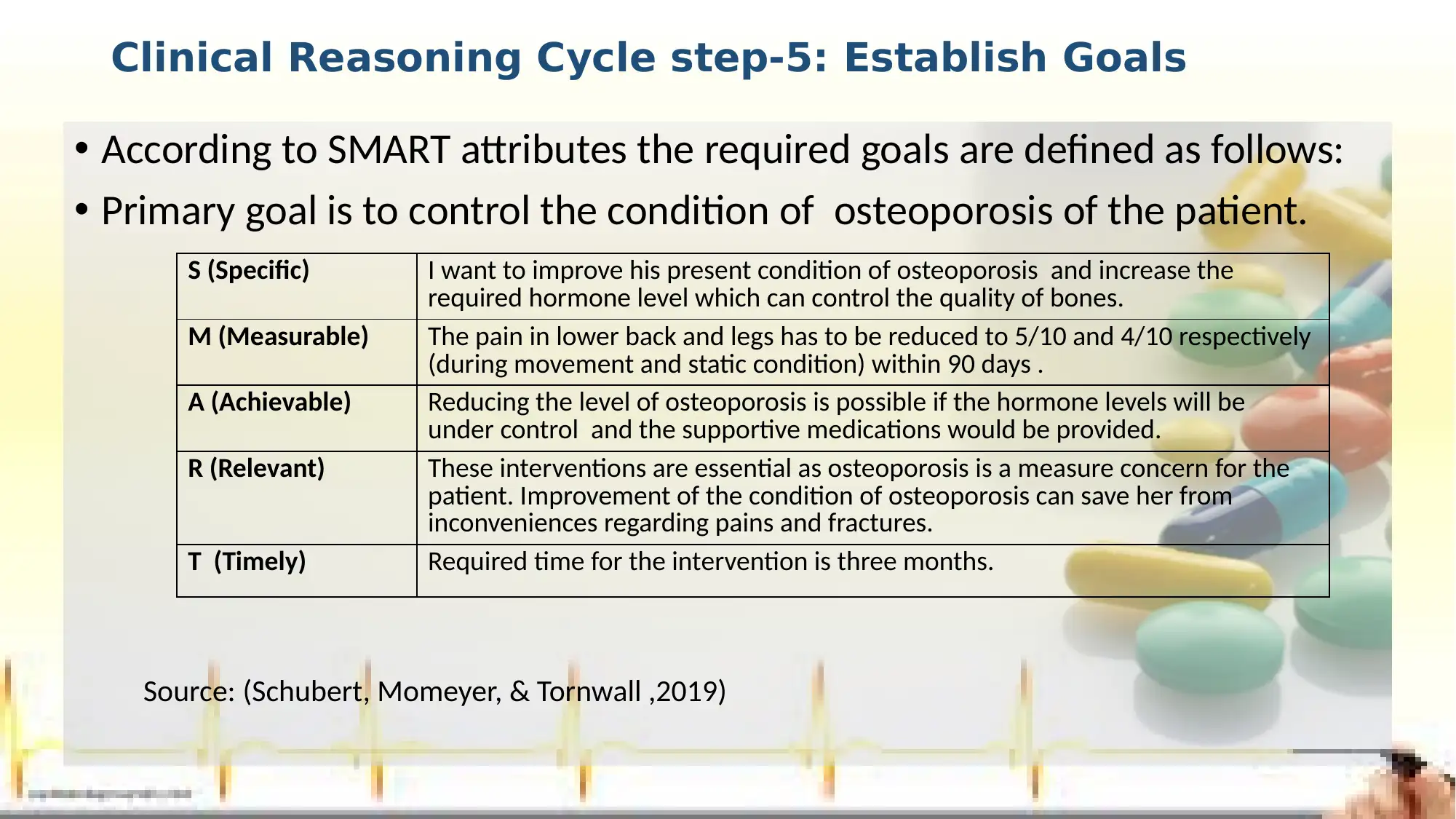
Clinical Reasoning Cycle step-5: Establish Goals
• According to SMART attributes the required goals are defined as follows:
• Primary goal is to control the condition of osteoporosis of the patient.
Source: (Schubert, Momeyer, & Tornwall ,2019)
S (Specific) I want to improve his present condition of osteoporosis and increase the
required hormone level which can control the quality of bones.
M (Measurable) The pain in lower back and legs has to be reduced to 5/10 and 4/10 respectively
(during movement and static condition) within 90 days .
A (Achievable) Reducing the level of osteoporosis is possible if the hormone levels will be
under control and the supportive medications would be provided.
R (Relevant) These interventions are essential as osteoporosis is a measure concern for the
patient. Improvement of the condition of osteoporosis can save her from
inconveniences regarding pains and fractures.
T (Timely) Required time for the intervention is three months.
• According to SMART attributes the required goals are defined as follows:
• Primary goal is to control the condition of osteoporosis of the patient.
Source: (Schubert, Momeyer, & Tornwall ,2019)
S (Specific) I want to improve his present condition of osteoporosis and increase the
required hormone level which can control the quality of bones.
M (Measurable) The pain in lower back and legs has to be reduced to 5/10 and 4/10 respectively
(during movement and static condition) within 90 days .
A (Achievable) Reducing the level of osteoporosis is possible if the hormone levels will be
under control and the supportive medications would be provided.
R (Relevant) These interventions are essential as osteoporosis is a measure concern for the
patient. Improvement of the condition of osteoporosis can save her from
inconveniences regarding pains and fractures.
T (Timely) Required time for the intervention is three months.
Paraphrase This Document
Need a fresh take? Get an instant paraphrase of this document with our AI Paraphraser
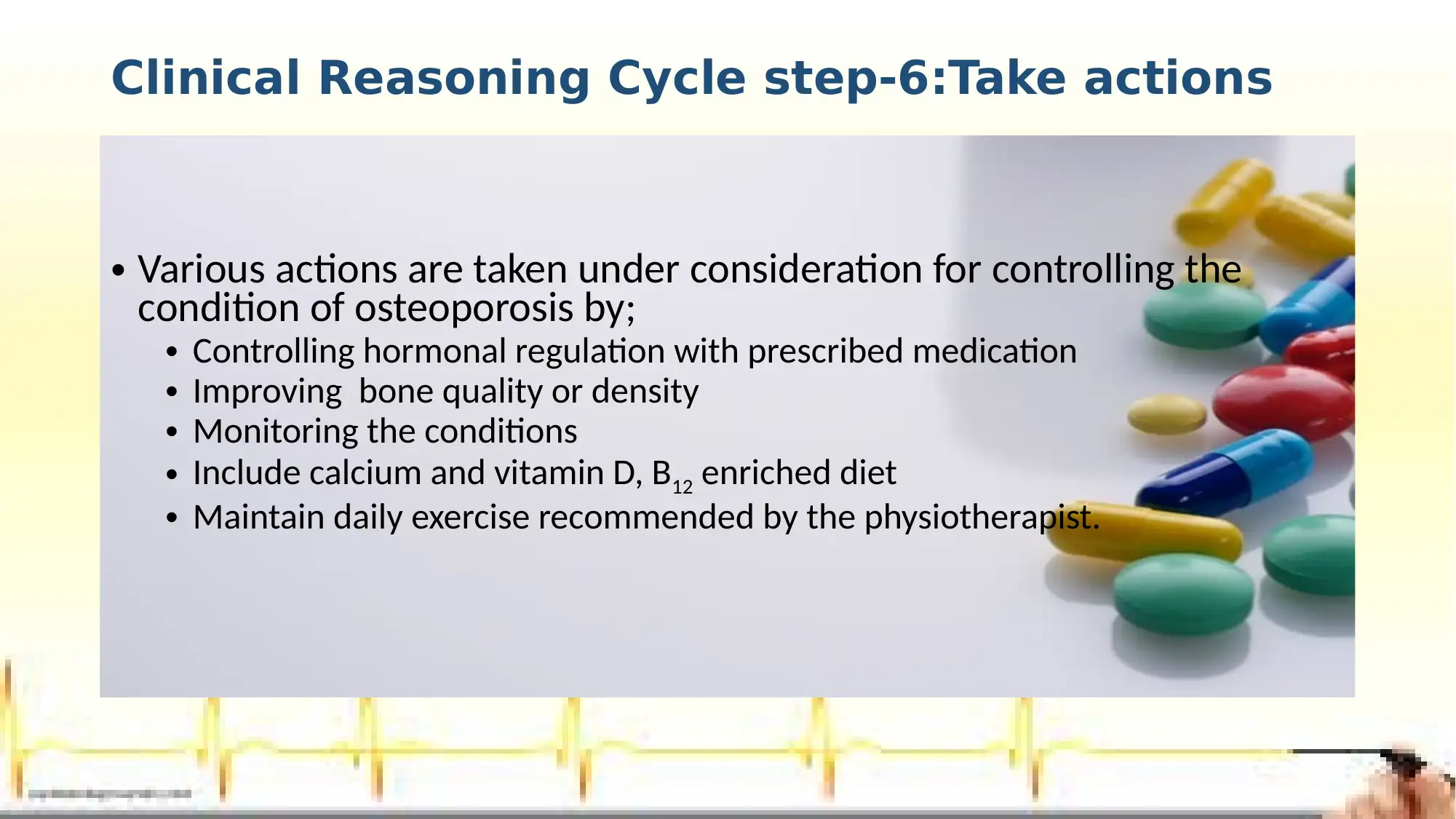
Clinical Reasoning Cycle step-6:Take actions
• Various actions are taken under consideration for controlling the
condition of osteoporosis by;
• Controlling hormonal regulation with prescribed medication
• Improving bone quality or density
• Monitoring the conditions
• Include calcium and vitamin D, B12 enriched diet
• Maintain daily exercise recommended by the physiotherapist.
• Various actions are taken under consideration for controlling the
condition of osteoporosis by;
• Controlling hormonal regulation with prescribed medication
• Improving bone quality or density
• Monitoring the conditions
• Include calcium and vitamin D, B12 enriched diet
• Maintain daily exercise recommended by the physiotherapist.
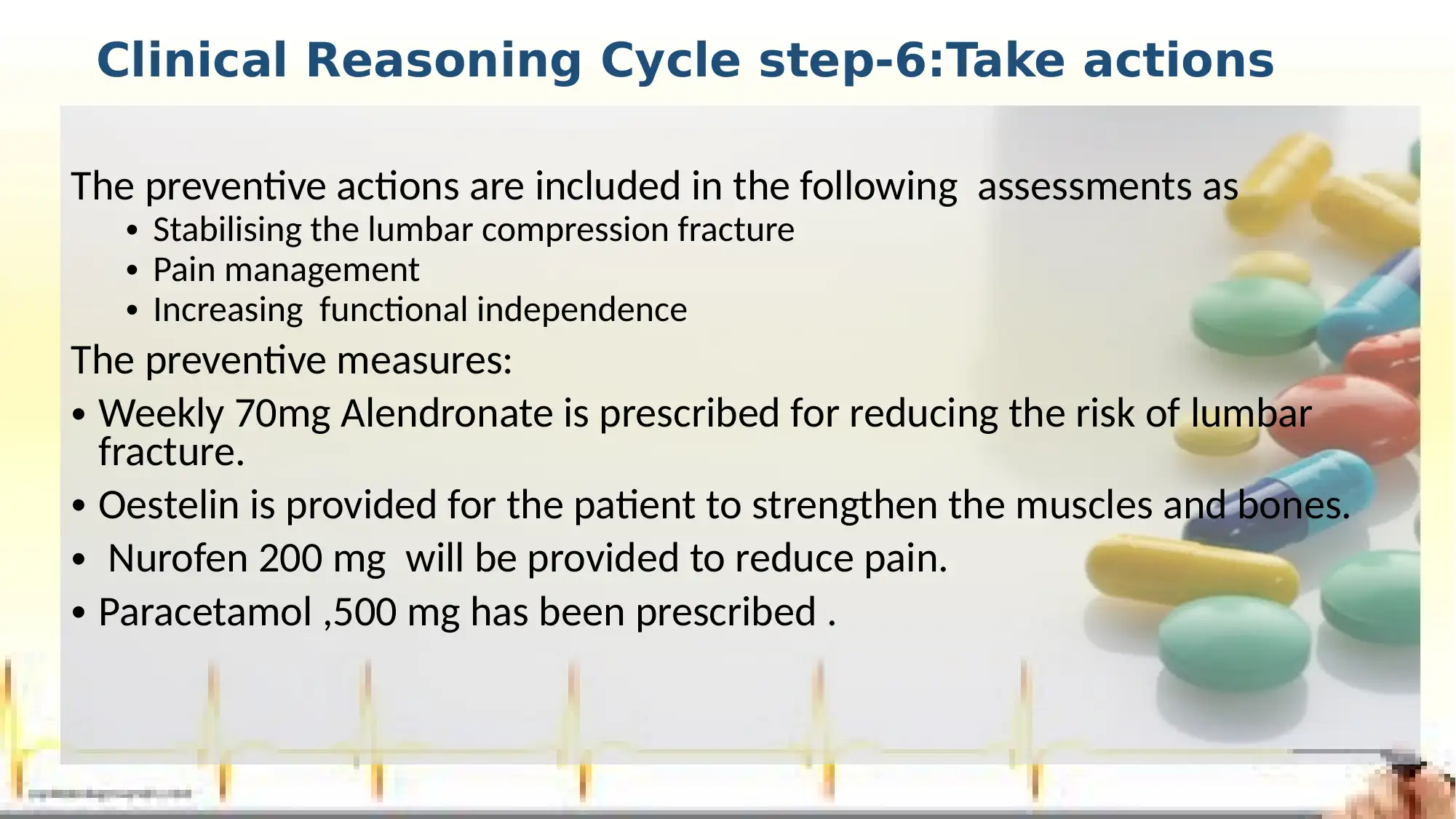
Clinical Reasoning Cycle step-6:Take actions
The preventive actions are included in the following assessments as
• Stabilising the lumbar compression fracture
• Pain management
• Increasing functional independence
The preventive measures:
• Weekly 70mg Alendronate is prescribed for reducing the risk of lumbar
fracture.
• Oestelin is provided for the patient to strengthen the muscles and bones.
• Nurofen 200 mg will be provided to reduce pain.
• Paracetamol ,500 mg has been prescribed .
The preventive actions are included in the following assessments as
• Stabilising the lumbar compression fracture
• Pain management
• Increasing functional independence
The preventive measures:
• Weekly 70mg Alendronate is prescribed for reducing the risk of lumbar
fracture.
• Oestelin is provided for the patient to strengthen the muscles and bones.
• Nurofen 200 mg will be provided to reduce pain.
• Paracetamol ,500 mg has been prescribed .
⊘ This is a preview!⊘
Do you want full access?
Subscribe today to unlock all pages.

Trusted by 1+ million students worldwide
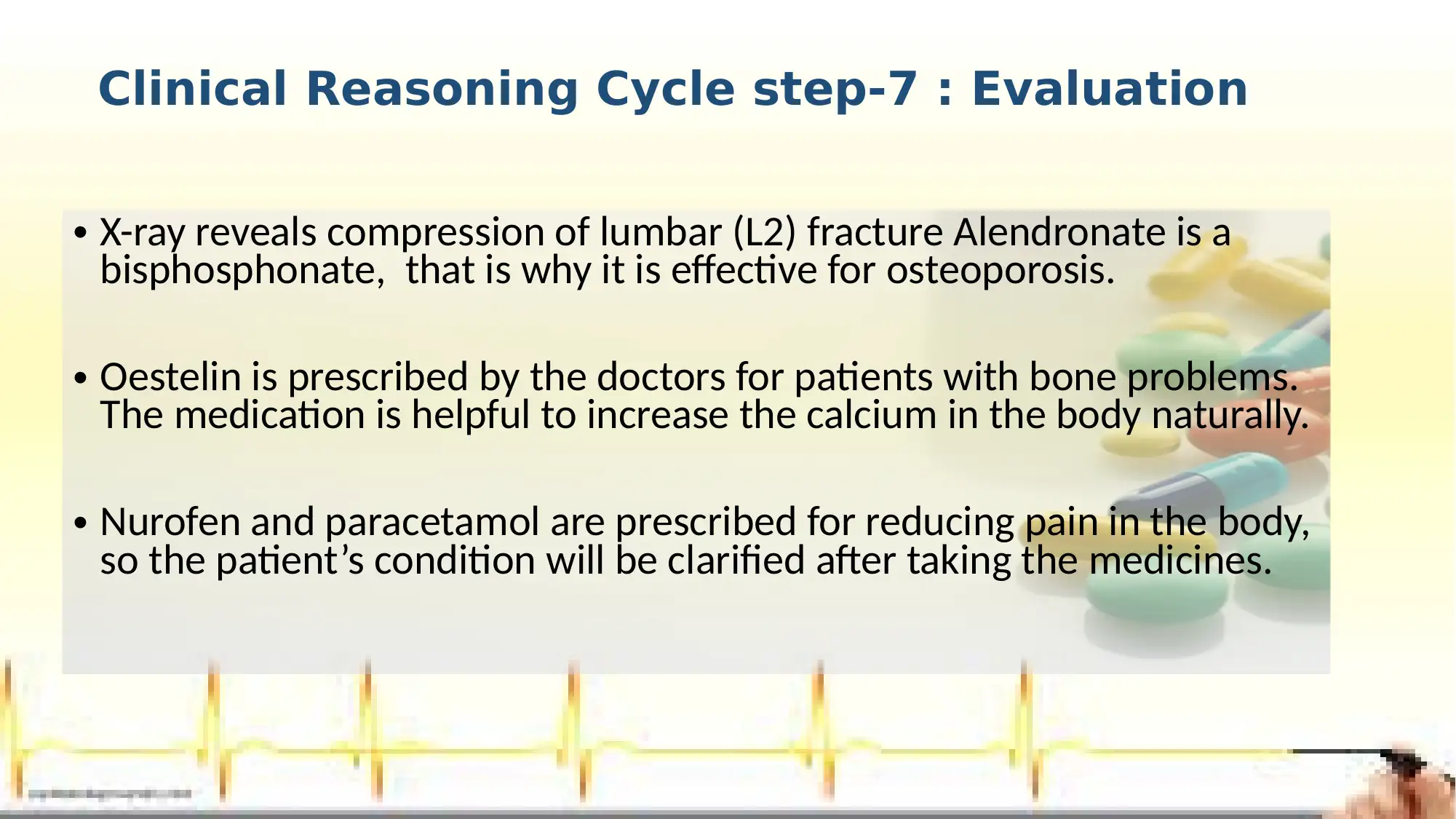
Clinical Reasoning Cycle step-7 : Evaluation
• X-ray reveals compression of lumbar (L2) fracture Alendronate is a
bisphosphonate, that is why it is effective for osteoporosis.
• Oestelin is prescribed by the doctors for patients with bone problems.
The medication is helpful to increase the calcium in the body naturally.
• Nurofen and paracetamol are prescribed for reducing pain in the body,
so the patient’s condition will be clarified after taking the medicines.
• X-ray reveals compression of lumbar (L2) fracture Alendronate is a
bisphosphonate, that is why it is effective for osteoporosis.
• Oestelin is prescribed by the doctors for patients with bone problems.
The medication is helpful to increase the calcium in the body naturally.
• Nurofen and paracetamol are prescribed for reducing pain in the body,
so the patient’s condition will be clarified after taking the medicines.
Paraphrase This Document
Need a fresh take? Get an instant paraphrase of this document with our AI Paraphraser
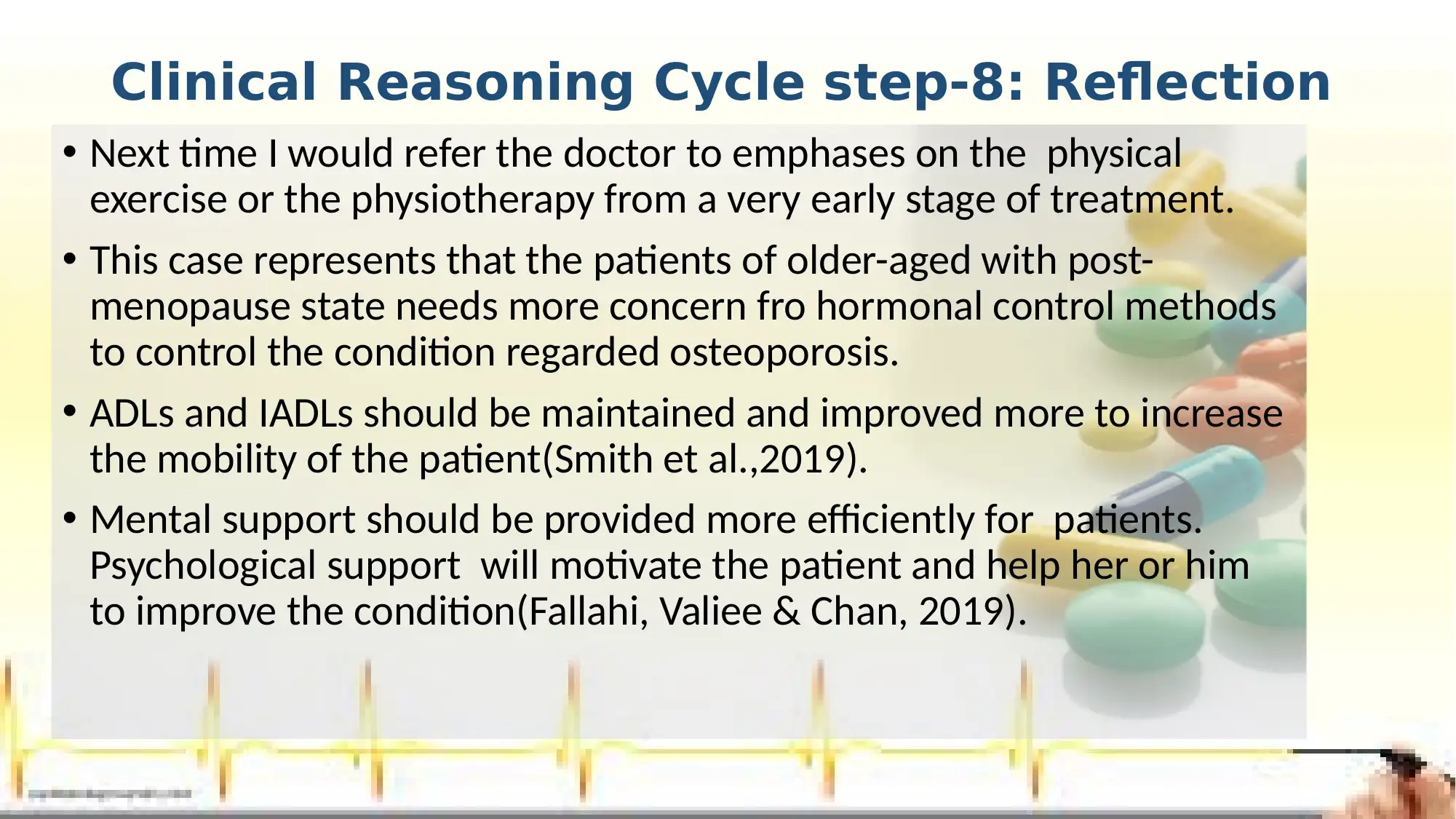
Clinical Reasoning Cycle step-8: Reflection
• Next time I would refer the doctor to emphases on the physical
exercise or the physiotherapy from a very early stage of treatment.
• This case represents that the patients of older-aged with post-
menopause state needs more concern fro hormonal control methods
to control the condition regarded osteoporosis.
• ADLs and IADLs should be maintained and improved more to increase
the mobility of the patient(Smith et al.,2019).
• Mental support should be provided more efficiently for patients.
Psychological support will motivate the patient and help her or him
to improve the condition(Fallahi, Valiee & Chan, 2019).
• Next time I would refer the doctor to emphases on the physical
exercise or the physiotherapy from a very early stage of treatment.
• This case represents that the patients of older-aged with post-
menopause state needs more concern fro hormonal control methods
to control the condition regarded osteoporosis.
• ADLs and IADLs should be maintained and improved more to increase
the mobility of the patient(Smith et al.,2019).
• Mental support should be provided more efficiently for patients.
Psychological support will motivate the patient and help her or him
to improve the condition(Fallahi, Valiee & Chan, 2019).

References
Fallahi, A., Valiee, S., & Chan, S. W. C. (2019). Needs of Women with Osteoporosis in Disease Self-Management: A Qualitative
Study. Health Scope, (In Press).
Foster, B. L., & Hujoel, P. P. (2018). Vitamin D in dentoalveolar and oral health. In Vitamin D (pp. 497-519). Academic Press.
Granas, A. G., Bakken, M. S., Ruths, S., & Taxis, K. (2018). Deprescribing for frail older people–Learning from the case of Mrs.
Hansen. Research in Social and Administrative Pharmacy, 14(6), 612-616.
Hirsch, C. (2018). In postmenopausal women with osteoporosis, romosozumab followed by alendronate reduced fractures vs
alendronate alone. Annals of internal medicine, 168(2), JC3-JC3.
Ishimoto, Y., Yamada, H., Curtis, E., Cooper, C., Hashizume, H., Minamide, A., ... & Yoshida, M. (2018). Spinal Endoscopy for Delayed-
Onset Lumbar Radiculopathy Resulting from Foraminal Stenosis after Osteoporotic Vertebral Fracture: A Case Report of a New
Surgical Strategy. Case reports in orthopedics, 2018.
Miller, P. D., Hattersley, G., Riis, B. J., Williams, G. C., Lau, E., Russo, L. A., ... & Fitzpatrick, L. A. (2016). Effect of abaloparatide vs
placebo on new vertebral fractures in postmenopausal women with osteoporosis: a randomized clinical trial. Jama, 316(7), 722-
733.
Naylor, K. E., Bradburn, M., Paggiosi, M. A., Gossiel, F., Peel, N. F. A., McCloskey, E. V., ... & Eastell, R. (2018). Effects of discontinuing
oral bisphosphonate treatments for postmenopausal osteoporosis on bone turnover markers and bone density. Osteoporosis
International, 29(6), 1407-1417.
Schubert, C., Momeyer, M. A., & Tornwall, J. (2019). Nursing Peer Review in an Online Course. Journal of Nursing Education, 58(6),
374-374.
Smith, M. L., Heeren, T. C., Ranker, L. R., & Fredman, L. (2019). Assessing the Role of Selection Bias in the Protective Relationship
Between Caregiving and Mortality: the Caregiver-Study of Osteoporotic Fractures. American journal of epidemiology.
Fallahi, A., Valiee, S., & Chan, S. W. C. (2019). Needs of Women with Osteoporosis in Disease Self-Management: A Qualitative
Study. Health Scope, (In Press).
Foster, B. L., & Hujoel, P. P. (2018). Vitamin D in dentoalveolar and oral health. In Vitamin D (pp. 497-519). Academic Press.
Granas, A. G., Bakken, M. S., Ruths, S., & Taxis, K. (2018). Deprescribing for frail older people–Learning from the case of Mrs.
Hansen. Research in Social and Administrative Pharmacy, 14(6), 612-616.
Hirsch, C. (2018). In postmenopausal women with osteoporosis, romosozumab followed by alendronate reduced fractures vs
alendronate alone. Annals of internal medicine, 168(2), JC3-JC3.
Ishimoto, Y., Yamada, H., Curtis, E., Cooper, C., Hashizume, H., Minamide, A., ... & Yoshida, M. (2018). Spinal Endoscopy for Delayed-
Onset Lumbar Radiculopathy Resulting from Foraminal Stenosis after Osteoporotic Vertebral Fracture: A Case Report of a New
Surgical Strategy. Case reports in orthopedics, 2018.
Miller, P. D., Hattersley, G., Riis, B. J., Williams, G. C., Lau, E., Russo, L. A., ... & Fitzpatrick, L. A. (2016). Effect of abaloparatide vs
placebo on new vertebral fractures in postmenopausal women with osteoporosis: a randomized clinical trial. Jama, 316(7), 722-
733.
Naylor, K. E., Bradburn, M., Paggiosi, M. A., Gossiel, F., Peel, N. F. A., McCloskey, E. V., ... & Eastell, R. (2018). Effects of discontinuing
oral bisphosphonate treatments for postmenopausal osteoporosis on bone turnover markers and bone density. Osteoporosis
International, 29(6), 1407-1417.
Schubert, C., Momeyer, M. A., & Tornwall, J. (2019). Nursing Peer Review in an Online Course. Journal of Nursing Education, 58(6),
374-374.
Smith, M. L., Heeren, T. C., Ranker, L. R., & Fredman, L. (2019). Assessing the Role of Selection Bias in the Protective Relationship
Between Caregiving and Mortality: the Caregiver-Study of Osteoporotic Fractures. American journal of epidemiology.
⊘ This is a preview!⊘
Do you want full access?
Subscribe today to unlock all pages.

Trusted by 1+ million students worldwide

Thank You
1 out of 7
Related Documents
Your All-in-One AI-Powered Toolkit for Academic Success.
+13062052269
info@desklib.com
Available 24*7 on WhatsApp / Email
![[object Object]](/_next/static/media/star-bottom.7253800d.svg)
Unlock your academic potential
Copyright © 2020–2025 A2Z Services. All Rights Reserved. Developed and managed by ZUCOL.



